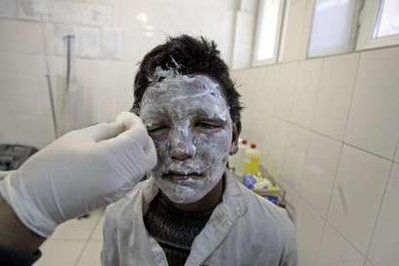By Michelle Nichols
KABUL - Afghan Khan Mohammad's once long henna-stained beard is burned up to his chin and his face is swollen and raw after a gas lamp exploded because it was placed too close to the family's wood-burning stove.

Enzer Gul, the 11-year-old son of Khan Mohammad, is treated after his face was burnt in Kabul January 9, 2011. (Photo: REUTERS/Hamid Sayedi)
As temperatures drop well below freezing during the country's harsh winter, bombs and bullets from a near-decade long war against a Taliban-led insurgency are not the only threat -- just trying to light a home and stay warm can be deadly.
"We were using gas for a lamp and cooking food on the bukhari (stove) and the gas bottle was too close and got too hot," Mohammad said of the explosion, which also hurt his 11-year old son. They were being treated at Ahmed Shah Baba hospital in eastern Kabul.
But aside from the threat of burns, the main problem posed by heating and cooking is the smoke, which the World Health Organization said kills 54,000 Afghans a year. Most of those killed are children under five, it said.
The WHO has also ranked the problem as one of the worst health risks facing the poor. Burning solid fuels inside is also a large problem for other regional countries like Pakistan, China and India.
More than 95 percent of Afghanistan's 30 million people burn solid fuels, such as wood and coal, in their homes, said the World Health Organization, making it one of the top 10 countries worst-affected by indoor pollution.
By contrast, 2,412 civilians were killed by conflict-related violence and 3,803 wounded in the first ten months of 2010, said the United Nations, the most violent year since late 2001 when U.S.-backed Afghan forces ousted the Taliban.
Afghan families typically use a wood-burning bukhari, a drum-shaped stove made of thin metal, or a sandali, a pit of burning coal under a small table covered by a heavy blanket, which people put their feet under to keep warm.
The smoke can lead to childhood pneumonia, lung cancer, bronchitis and cardiovascular disease, while also contributing to climate change through greenhouse gas emissions.
Indoor pollution mainly affects women and children because they spend the most time at home, said Afghanistan's acting Minister of Public Health Dr Suraya Dalil.
"Indoor pollution is one of the areas that threatens the survival of inhabitants," she said. "We're working ... to advocate for measures that would reduce indoor pollution including things like provision of electricity, that increases the safety as well as reduces the pollution in the house."
Afghanistan's infrastructure has been shattered by three decades of conflict and even electricity in the country's capital Kabul is unreliable. A near-decade long war makes security a top priority even as authorities try to rebuild the aid-reliant economy.
INDOOR SMOKE KILLS NEARLY TWO MILLION A YEAR
Afghanistan is one of the poorest countries in the world, where children make up half the population. A quarter of children die before age five and the average life expectancy is 44 years.
Dr Bashir Noormal, director general of the Afghan Public Health Institute, said smoke from heating and cooking in Afghan homes "causes burns, carbon monoxide poisoning, respiratory illnesses and diseases and deaths."
"Inhalation of coal, wood and straw has been related to lung cancer and cancers of the head and neck," he added. "Chronic exposure to wood smoke also significantly increases the risk of cervical cancer in Human Papilloma Virus infected women."
The Human Papilloma Virus causes cervical cancer. But, in a country devastated by war, Noormal said there was no data on how many cancer cases could have been caused by indoor pollution.
Traditional cookstoves and open fires are the primary means of cooking and heating for nearly three billion people, according to the U.N. Foundation's Global Alliance for Clean Cookstoves.
Exposure to the smoke kills nearly two million people a year globally and sickens millions more, said the alliance, which is working to help produce clean cookstoves and aims to have 100 million homes using clean and efficient stoves and fuels by 2020.
In September the United States committed $50 million over five years to the alliance.
Honorita Bernasor, a Medecins Sans Frontieres (Doctors Without Borders) emergency doctor at Kabul's Ahmed Shah Baba hospital, said winter in Afghanistan brought cases of burns and carbon monoxide poisoning. In December, the hospital treated nearly 100 cases of burns caused by heating or cooking.
"We will be expecting more cases when the temperature goes lower," she said. "Bukharis are normally in the middle of the room and the children run around and put their hands everywhere ... We see a lot of carbon monoxide poisoning as well."
Qudratullah Nasrat, an emergency room doctor at the same hospital, said some of the symptoms of carbon monoxide poisoning such as headaches and dizziness were well known to Afghans.
"A lot of people treat themselves by sitting outside to breath the fresh air," he said. "They get to know the symptoms."
(Editing by Miral Fahmy)



